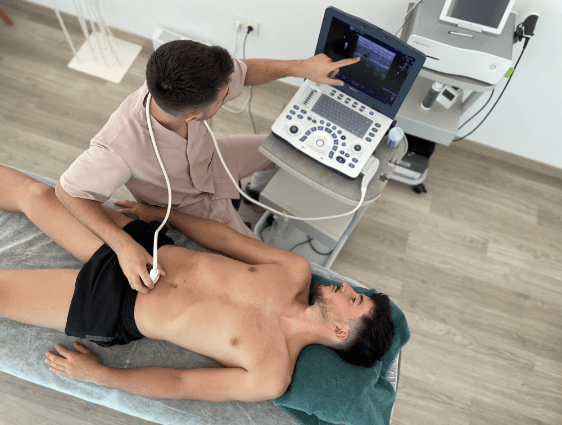
An increasingly important technique within the clinical practice of the physiotherapist.
Musculoskeletal ultrasound is an important tool we use to prepare an objective clinical diagnosis for the patient. Furthermore, musculoskeletal ultrasound allows us to safely and accurately perform various invasive techniques, such as: dry needling, which involves complex muscle approaches in the vicinity of delicate neighboring structures such as neurovascular bundles, ganglia or an organ; percutaneous neuromodulation, where it is used to locate the peripheral nerve that we want to treat, and; EPTE, where it provides greater efficacy by allowing for precision entry of the needle in the area in which the tendon injury is located.
This technique is becoming increasingly valuable within the clinical practice of the physiotherapist, for physiotherapeutic diagnosis as well as for the subsequent treatment.. There is significant, reliable scientific evidence that supports the use of ultrasound in the clinical reasoning process. It allows the physiotherapist to understand and interpret the deficiencies presented by the patient in the best possible way.
How musculoskeletal ultrasound works
The ultrasound system produces high-frequency sound waves to produce images of tissues. The sound waves are sent out and bounce back when they reach the tissues and the transducer or probe is responsible for converting the sound waves into the images we see on the screen.

Ultrasound only allows us to see soft tissue, that is, periarticular cartilage, ligaments, nerves, muscles, and tendons. As for bones, we can only visualize the cortical bone since, due to its high density, ultrasound cannot penetrate it. This allows us to identify certain traumatic or stress fractures and fissures, although in these cases the most accurate diagnostic test would be radiography (X-ray).
Tell us about your particular case. We can explain whether musculoskeletal ultrasound is right for you. Furthermore, at the LH Physiotherapy Clinic, we will conduct a preliminary study that details the steps to follow.
Frequently asked questions - musculoskeletal ultrasound
What is musculoskeletal ultrasound and what does it involve?
Musculoskeletal ultrasound is an imaging technique that uses ultrasound waves to visualise muscles, tendons, ligaments, joints, and other soft tissues of the musculoskeletal system in real time. It is a non-invasive procedure that helps diagnose various conditions and guide therapeutic treatments.
What is musculoskeletal ultrasound used for?
It is used to diagnose injuries such as muscle tears, tendinopathies, ligament sprains, bursitis, arthritis, and to detect foreign bodies in soft tissues. Additionally, it is useful for monitoring the progress of injuries and guiding therapeutic procedures such as injections.
How should I prepare for a musculoskeletal ultrasound?
Generally, no special preparation is required. It is recommended to wear comfortable clothing that allows easy access to the area being examined. There is no need to fast or stop taking medication unless specifically instructed by a doctor.
Is musculoskeletal ultrasound painful?
No, it is a painless procedure. The patient may feel slight pressure when the transducer is moved over the skin, but it should not cause pain. In cases of inflammation or sensitivity in the area, there may be mild discomfort.
How long does a musculoskeletal ultrasound take?
The examination usually takes 20 to 30 minutes, depending on the complexity and size of the area being assessed.
Does musculoskeletal ultrasound emit radiation?
No, this procedure does not use ionising radiation. It employs ultrasound waves, making it safe and suitable for patients of all ages, including children and pregnant women.
What are the advantages of musculoskeletal ultrasound compared to other imaging techniques?
It provides real-time imaging, allows dynamic assessments, is more accessible and cost-effective, and does not involve radiation exposure. Additionally, it enables highly accurate guidance for therapeutic procedures.
